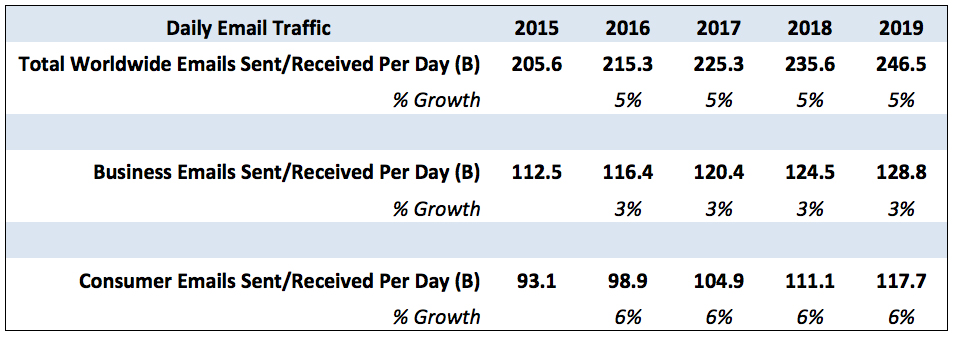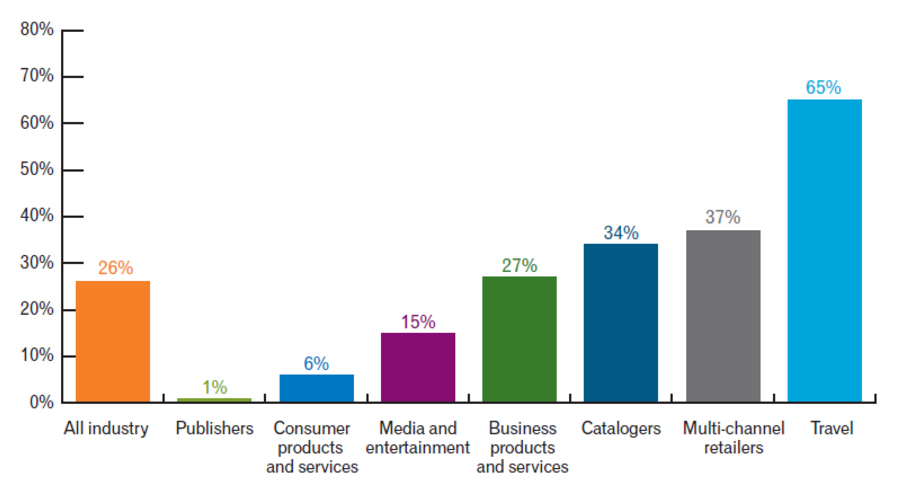Around the world, the number of emails that are sent and received every day could top 246 billion in two years’ time, research shows. It’s a figure that is constantly growing as email is still considered the vital channel for most marketers. How do you maximise it? Here are trends to watch out for and ways to optimise your email messages:
Email represents a major communications channel. By 2019, the volume of emails could reach as many as 246 billion per day. Marketing emails continue to account for major portion of email traffic, primarily because of their success.
According to Econsultancy, marketing campaigns that rely on email typically bring a return on investment of 73 per cent or more. That exceeds the 67 and 62 per cent ROI that respectively comes from SEO and content marketing.
Despite the role of email as the backbone of the marketing community, the medium does not bring either automatic or guaranteed success. Technology and audiences constantly evolve, requiring businesses to update their tactics to remain relevant. Business competitiveness and profitability in 2017 increasingly depend on the following trends.
Context-driven emails
Knowing their power, modern customers expect to feel valued and appreciated. As a result, marketers must increasingly craft messages that resonate with their audience on an individual level. Such personalisation, together with the custom content and contexts that make them possible, depends on automation to reduce the cost of execution.
As a result of new technologies and strategies, email campaigns can achieve remarkable levels of relevance and responsiveness. In fact, properly equipped marketing professionals can respond in real time to the needs of particular individuals.
Experian revealed that personalisation can increase by 600 per cent the transaction rate generated by marketing emails. Tactics as simple as injecting subject lines with the first name of a recipient can alone increase the number of opened emails by 2.6 per cent.
Profile-based segmentation adds to the potential for email marketers. Content that relates to the demographics of each customer tends to build rapport with recipients and, therefore, prompt positive responses.
Interactive content
Brand awareness and authority has fuelled the trend of including interactive content in marketing messages. Rather than waiting for people to click through to a company website, marketers now captivate and engage audiences through embedded content. Bringing conversion one step closer has already produced impressive results.
Problems that continue to limit the amount of interaction of marketing messages include technical details where email clients do not support certain content types. Another issue, tracking recipient behaviour and measuring audience reaction, continues to challenge marketers.
Already, more than two-thirds of email recipients can interact with content within their email software. Coinciding with the trend toward interactive content, the use of new metrics that measure engagement have displaced traditional measures such as click-through rates while measuring the effectiveness of email campaigns.
Machines for targeted content
The effectiveness of context-based and interactive email marketing tactics have spurred innovation as software developers scramble to meet demand. Business owners and managers yearn for ways to improve the precision, productivity and profitability of their marketing efforts.
New services have simplified the job of content automation using refined data sources and algorithms to produce content that generates results with a minimal use of human resources. Machine learning has taken centre stage in the development of new systems that can support emerging trends. As a result, marketers can do more with less effort while creating an exceptional experience for audience members.
Video content
Customers increasingly expect to see video content and therefore perpetuate its trend toward prominence. Already, video content has transformed the online world and now has gained momentum with email marketers.
Everything from animated images to lengthy videos can cause people to open marketing emails and keep them open longer than they would text-based messages. As a result, the social video trend shows no sign of subsiding.
Thanks to the ubiquity of HTML5, the compatibility problems that before limited the integration of video have been resolved. Data collected as recently as last November shows that Apple email applications, which do support HTML5, opened 53% of all email messages. That number continues to increase even as other email clients upgrade to HTML 5. Soon, marketers will no longer need to include fallback measures for recipients who cannot open video in email.
Mobile optimisation
54% of all marketing emails are opened on mobile devices. This trend underscores the dominance of mobile users in the online world. Moreover, the revenue generated by marketing email campaigns doubles that of messages opened on the desktop, according to YesMail.
Profitability continues to drive mobile optimisation in 2017, fuelling a trend that seems likely to indefinitely continue. Marketers are enhancing mobile ROI by sending concise messages that mobile users can easily interact with on smartphones. Additionally, an increasing need for relevance has made quality more important than quantity when sending emails.
According to eMailMonday, messages that are between 50 and 125 words long are the most effective marketing emails. As screens and attention spans continue to shrink, the trend toward shorter messages will intensify.
Predictive lead scoring
Technology has paved the way for scoring leads based on their predictive performance. By harnessing the trend of collecting more user data, companies can increase the value of their lists and, by extension, their ROI from email marketing. As predictive lead scoring gains momentum in the industry, it promises to improve onboarding efforts and get precisely targeted content in all the right inboxes.
Cross-channel measurements and big data
Practically every email marketing trend depends on the availability of large amounts of information. Fortunately, big data is up to the task. Companies can use internal and external data sources to determine the right time and message to send to contacts.
Information from web logs and analytics, social media data, CRM and ERP feed business intelligence systems that make targeted email marketing messages possible at a very low price point.
Ultimately, big data continues building momentum because it empowers marketers with the ability to create a comprehensive and circumspect view of each customer and match each persona with an ideal marketing message.
Automated emails
Expect the triggering of email messages based on particular customer actions to help shape email marketing throughout the rest of this year. In response to actions such as registering as a website user or mailing list subscriber, businesses can reinforce the customer experience.
An Epsilon study found that recipients open automated emails at almost double the rate (49%) at which they open traditional marketing messages. Some companies that have harnessed this trend have conversion rates of 40 per cent or more.
Another previously discussed trend, context, helps explain why automated emails work. Messages regarding abandoned shopping carts and confirming registrations represent just a sample of the many transactional triggers that reach customers concurrent with their actions. In many settings, automated emails account for the majority of revenue generated from email marketing.
Email marketing trends affecting businesses in 2017 depend on contextual relevance, personalisation and mobility. Also, the importance of big data is growing as more firms use increasing amounts of data points to precisely define their prospects and customers. Furthermore, business owners and marketing professionals should stay alerted for lucrative new technologies and tactics that can keep them ahead of their competitors.
Read also:
Using personalisation and contextual marketing to transform email marketing campaigns
Dos and don’ts of integrating CRM with marketing automation








Leave your thoughts